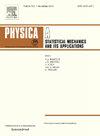通过疏散演练和微观模型探讨楼梯间人员疏散特征
IF 2.8
3区 物理与天体物理
Q2 PHYSICS, MULTIDISCIPLINARY
Physica A: Statistical Mechanics and its Applications
Pub Date : 2025-06-01
DOI:10.1016/j.physa.2025.130726
引用次数: 0
摘要
通过疏散演练和修正的最优步骤模型,研究了楼梯间人员疏散特性。通过疏散演练,导出了通过不同楼梯段、不同楼梯平台和两段楼梯的下降速度,平均速度分别为0.76 m/s、0.63 m/s和0.92 m/s。给出了楼梯落地和楼梯飞行的密度-速度关系,并与SFPE手册中的密度-速度关系进行了比较。对比结果表明,楼梯平台上的转弯运动与地面走廊上的直线运动存在显著差异,文化差异可能是影响楼梯上移动速度的一个因素。根据疏散演练的数据,我们基于改进的最优步模型进行了模拟,其中引入了额外的导航场,以实现楼梯着陆时的真实转弯运动。给出了疏散曲线和各楼梯段疏散人数的时间演化等仿真结果,与演练结果吻合较好。这表明我们的修正模型确实能够再现多层楼梯间中的人员疏散行为,并且传统概念在现代复杂建筑环境和不同人群场景中仍然是准确的。该模型可以进一步发展为高层建筑楼梯间疏散的最优疏散策略。本文章由计算机程序翻译,如有差异,请以英文原文为准。
Exploring occupant evacuation characteristics in the stairwell through an evacuation drill and a microscopic model
Occupant evacuation characteristics in the stairwell is studied through an evacuation drill and a revised optimal steps model. Through the evacuation drill, the descent speeds through different stair sections, different stair landings and two flights of stairs are derived, and the mean speeds are 0.76 m/s, 0.63 m/s and 0.92 m/s, respectively. The density-speed relations on stair landing and stair flight are also presented and compared with those in the SFPE Handbook. The comparison result indicates that turning movement on stair landing is significantly different from straight movement in corridor on level ground, and that culture difference may be a factor affecting movement speed on stairs. With the data from the evacuation drill, we perform a simulation based on a revised optimal steps model, where an additional navigation field is introduced to achieve realistic turning movement on stair landing. Simulation results such as evacuation curve and time evolution of evacuee number in each stair section are presented, and they are in good agreement with drill results. It demonstrates that our revised model does have the ability to reproduce occupant evacuation performance in multi-floor stairwell and that traditional concepts remain accurate in modern complex building environments and diverse crowd scenarios. This model can be further developed to generate the optimal evacuation strategy during stairwell evacuation in high-rise building.
求助全文
通过发布文献求助,成功后即可免费获取论文全文。
去求助
来源期刊
CiteScore
7.20
自引率
9.10%
发文量
852
审稿时长
6.6 months
期刊介绍:
Physica A: Statistical Mechanics and its Applications
Recognized by the European Physical Society
Physica A publishes research in the field of statistical mechanics and its applications.
Statistical mechanics sets out to explain the behaviour of macroscopic systems by studying the statistical properties of their microscopic constituents.
Applications of the techniques of statistical mechanics are widespread, and include: applications to physical systems such as solids, liquids and gases; applications to chemical and biological systems (colloids, interfaces, complex fluids, polymers and biopolymers, cell physics); and other interdisciplinary applications to for instance biological, economical and sociological systems.

 求助内容:
求助内容: 应助结果提醒方式:
应助结果提醒方式:


